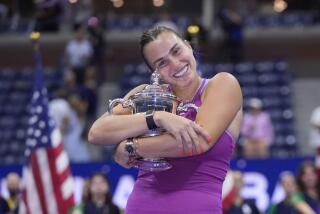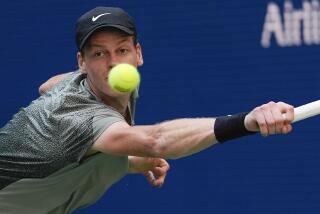Start spreading the news: It’s a cramp!
- Share via
They love to turn up the volume to Sinatra’s “New York, New York” at the U.S. Open tennis tournament. While huge crowds move around in ever-present heat and humidity, they are told in song, constantly, that if you can make it there, you’ll make it anywhere.
The tennis players would second that. Their only request might be that, on top of the big paychecks and trophies, somebody might also hand out Purple Hearts.
It is Labor Day weekend, and the toughest tournament in the world to survive, much less win, is in full bombast.
The first week was somewhat predictable, other than record numbers of players defaulting. Sinatra would be shaking his head in disgust.
Labor Day weekend arrives in Flushing Meadow and, as always, it is game on. Time for the weird and wonderful. Sometimes, even the sad.
Rafael Nadal, seeded second, was matched against David Nalbandian. The Argentine is Nadal’s worst nightmare. He once had to play till 3 a.m. at Indian Wells to beat the now 29-year-old Nalbandian. Afterward, to a gathering of six reporters, working on never-ending Internet deadlines and too much caffeine, Nadal confessed, “I have no idea how to play that guy.”
But Sunday in New York, there was the ultimate indication that Nadal will never be able to take Nalbandian lightly, even after winning, 7-6 (5), 6-1, 7-5.
In the giant news conference room after the match, Nadal sat in front of the microphone and, suddenly, frighteningly, began to grimace in obvious pain and slither off his chair and out of sight. He had cramps and was OK after getting some treatment.
What a sight! This could start a trend in how to avoid the press:
So, Serena, would you like to comment on the suggested destination of that tennis ball to that lineswoman? Oh, sorry. Leg cramps.
If it had been anyone but Nadal, who would never ponder anything that devious, you’d stop and wonder.
There are few dull moments at the U.S. Open.
Donald Young, 22-year-old U.S. player, who has been a soon-to-be-great for so long that many thought he had become a never-going-to-make-it, won again. He has apparently decided that he is going to make it there, rather than somewhere else. Sinatra would be proud.
TV showed second-seeded Vera Zvonareva winning easily. It also showed her arguing with the chair umpire over a line call. Some tennis fans held their breath, remembering a few years ago, when Zvonareva, in frustration during a defeat on the Arthur Ashe main court, started ripping off all the tape on her injured legs. It went on for a couple of games and the chair umpire, to her credit, never offered the use of scissors.
But Sunday’s U.S. Open highlight was the Samantha Stosur-Maria Kirilenko match on the Grandstand court. This was the U.S. Open at its most wonderful craziness.
The two, vying for a spot in the quarterfinals, originally were scheduled to play on the Ashe Stadium court. Then, when men’s matches went long, they were moved to the second biggest court, Louis Armstrong, which used to be the main court until they built Ashe and shaved off the top level of Armstrong. Then Stosur and Kirilenko, who had expected to start on Armstrong about 4 p.m., were moved again -- to the Grandstand. There, they began about 8 p.m.
The Grandstand is as funky as the tournament itself. It is kind of an appendage to Armstrong. Picture having your home as a tennis facility, with a match going on in your living room and another in the backyard, with a view from your deck. Armstrong seats about 10,000, the Grandstand about 5,000.
And, if there is a better match going on in the Grandstand, people leave their seats in Armstrong and hang over the Armstrong walkway to watch the Grandstand match.
They were hanging over the walkway at Armstrong as things heated up with Stosur and Kirilenko. Stosur, who had taken 3 hours 16 minutes to win her previous match Friday over Nadia Petrova, 7-6 (5), 6-7 (5), 7-5, had won the first set and was in a take-no-prisoners tiebreaker with Kirilenko for the second.
Stunningly, three times in that tiebreaker, Stosur got a point, Kirilenko asked for review from the Hawkeye camera, and all three times Kirilenko was proven correct. Two off those were on match points.
Had that happened to Roger Federer, who hates the Hawkeye more than any other player, he would have torn the place apart. Stosur kept her poise and also overcame, in mid-service motion, the sudden sounds of a young girl, practicing a song on a microphone over on Armstrong for later ceremonies.
The U.S. Open is not only hot and crowded, but always noisy.
Eventually, Kirilenko won the tiebreaker, 17-15. That turned out to be the longest tiebreaker for women in a Grand Slam event. But Stosur won the match, giving her nearly six hours of court time in her last two matches.
Also Sunday, there was the sad.
Veteran tennis journalist and broadcaster Bud Collins slipped and injured his knee. He will return to Boston for surgery. Collins, 82, has probably been to 150 Grand Slam tournaments in his career. If he were going to be injured, it had to happen at the U.S. Open.
It is the nature of the beast.
bill.dwyre@latimes.com
More to Read
Go beyond the scoreboard
Get the latest on L.A.'s teams in the daily Sports Report newsletter.
You may occasionally receive promotional content from the Los Angeles Times.











